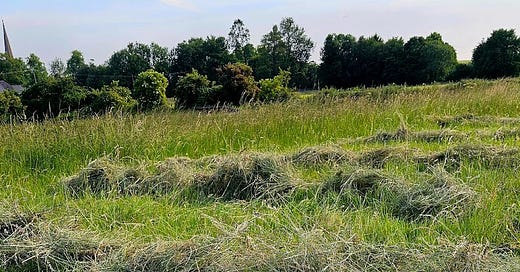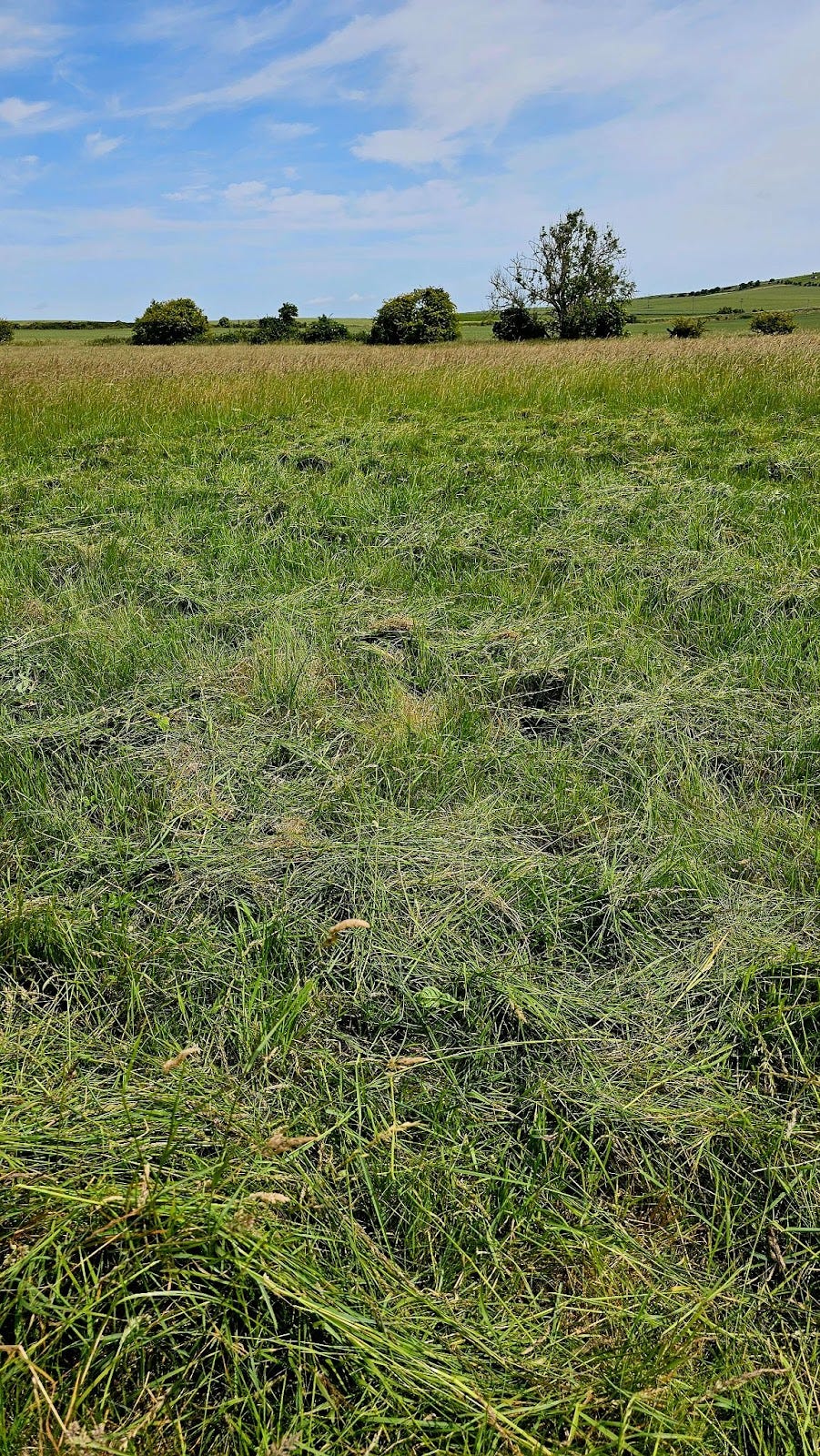This one probably belongs in The Resource Files, but I’m struggling to make that accessible to those who want to see the posts, so it’s going out as a general newsletter.
Why I Made Hay by Hand
Once again, we are struggling to find a contractor to cut and bale our hay. Our gates are narrow for modern tractors, and we are such small fry, we tend to go on the end of a very long list.
We’ve left the grass and put the sheep over it in the manner of ‘Deferred Grazing’ for two years. This is a regenerative practice whereby you don’t cut the summer grass, you just leave it there like standing hay and put the sheep over it in controlled sections over the winter. This has had the effect of making the grass tussocky and tough in places - wonderful for beetles and bugs, but just a little concerning if it gets out of hand.
I also wanted to try this because at heart I’m a bit of a ‘prepper’ and I just wonder ‘what would we do if…’ an awful lot of the time, and this is what we would do if … I couldn’t buy bales from anyone else because some natural or man made catastrophe (imagine?!) had made it so.
The Basics
The principles of making hay by hand are very different from the mechanised version we are used to.
Firstly, the tractor operator looks at the weather, and chooses a clear four or five days of warm, dry weather. Once they cut the hay, it is pretty much imperative that they turn it. (however many times is needed, indicated by the weather), row it up, bale it, and cart it in, before it rains.
Since the huge machinery can handle such vast quantities, a mistake is very costly. If you’ve mown 40 acres of hay, and the rain sets in, you’re a troubled woman.
Making hay by hand is more adaptable. I looked at the weather forecast for the week ahead on Friday, and it showed all clear, so I decided I would begin cutting on Monday, for up to ten days. With this method, you are cutting a small section each day, turning the previous day’s hay, rowing it all up at night, and repeating each morning. The days of cutting behind you accumulate, and on day four (if you’re carrying on) you will be cutting one day’s hay, turning two days’ hay, and possibly carting in the first day’s hay.
If the weather forecast changes, you can adapt your plan, and in this case, it did. Rain was now forecast for Saturday, so I decided to cut from Monday to Thursday and cart it all in on Friday. Please be aware, this was a tiny, tiny, experiment. I probably didn’t make enough to feed the goats for more than a week! But it was my experiment, my effort to find out if I could do it, and what I would learn.
Kit List
To make hay by hand the way I did it you need:
A scythe. We use Austrian scythes
An appropriate hay mowing blade
A sharpening stone
A long handled fork
A hay rake
A tarpaulin
Somewhere undercover to stack your hay
Our Austrian Scythes are typically fitted with orchard blades of 60cm, which we use for cutting browse for the goats. We also have a much shorter path blade, which does exactly what you might think it does!
We have two hay blades, 75cm and 85cm and with haymaking on the horizon, I carefully attached the 85cm blade in readiness. This, as it turned out, was a mistake. Our grass has been deferred grazing for two winters now, and it’s becoming tussocky, uneven, and very thick in patches. This is a state of affairs which was once rewardable under sustainable farming initiatives, before our government waved its magic wand and made them go away, because it is indeed a regenerative state of affairs. The tussocks are home to invertebrates and all sorts of other good stuff. But, when you see the masters of their art slicing effortlessly through their patches at the Green Scythe Fair, I can assure you, no tussocks are involved.
Also, that’s a long, long blade to handle on any grass, and I am (as I am continually saying!) and old woman of too great a girth, and insufficient height to wield such. So day one was a bit frustrating and I ended with ten rows of poorly cut grass, and a lot of good stuff left standing. On day two, having fired, I adjusted, and put on the 75cm blade, which was much more successful.
Daily Routine
Each morning, I took a fork up to the patch, turned and spread the previous days’ work, and then cut new rows. It’s preferable to scythe grass that’s still just a bit damp - not soggy and not crisping up - and as we were having a veritable heatwave, the window was quite narrow. I was also limited by how long I could stand the heat. With hindsight, I could have started earlier (I was starting around 7.00 - 7.30 am.)
Late in the afternoon, I took the rake up and raked the hay into rows, combining them as I went each day, so that four rows on day one were two on day two, and one on day three. This is because the hay is drying out and is lighter and closer to being cooked. We row up the hay so that dew and any possible shower will wet it the least amount possible.
On Friday, with rain threatening, Neil finished work a bit early and between us, we raked and forked the hay, loose, onto a tarpaulin, and dragged it down to the barn. It took three trips, and nicely filled a 6’x6’ hurdle enclosure. The sense of achievement was great, the quantity of forage, not so much!
Conclusions
The learning points were, I think, as follows:
Choose the appropriate blade. Bigger isn’t better unless the grass is clean and you are 6’3” and fit as a flea.
Start earlier, especially if it’s very hot. I hope I get the chance to do another run, hopefully with more typical weather, when I will be able to scythe for a little longer each day.
Pace yourself. If the world really does fall apart, and we have no choices but to make hay by hand, I might have to suffer a little more, but by far the better choice would be to build a team.
Decide where you’re putting it. We don’t aspire to build a proper stack, as Alex Langlands is doing at Chalke History Festival and it was actually more than it looked, we can’t just keep it in a big heap surrounded by hurdles in the middle of the barn!
Was it Worth It?
The pleasure and sense of achievement is powerful. That sense of being at one with the past, there are moments when you feel you could be in any century. It is hot, hard work, but it is quiet. You can listen to the birds (and the traffic!) and the school children at play down the slope, and hear the bell ringers practising as you rake up for the evening. You don’t need to wear ear protectors, a helmet or special clothing. I do wear boots, but many expert scythers work barefoot.
For me, it was ‘on my list’ and I so wanted to know that I could do it if I had to. I wanted to know what I didn’t know, what I’d need to improve, what I’d need to change in order to make ALL the hay I needed, so yes, it was one hundred percent worth it.
I can highly recommend learning to scythe, if you have livestock and grass, just in case. It’s a meditative yet physical activity, good for mind and body. One day, I swear I shall host and old women scything event. Let me know if you want to come!





Very well done indeed. I must admit I was a bit doubtful when you first said what you were going to do. Brings back memories of my childhood and blisters. Glad the weather held for you.
Thank you Nick. I mean, it's a token amount. But I'm chuffed!